Text Mining for Patent Analysis to Forecast Emerging Technologies in Wireless Power Transfer
Abstract
1. Introduction
2. Literature Review
3. Methodology
3.1. Research Framework
3.2. Data Collection
3.3. Preprocessing
3.4. Topic Extraction
3.4.1. TF-IDF
3.4.2. LDA
3.5. Clustering
3.6. Time Series Analysis
3.7. Innovation Cycle of Technology
4. Analysis Results
4.1. Filing Trends of Patents in WPT Technology
4.2. Extraction and Clustering of Topics from WPT Technology Patents
4.3. Identifying Vacant Technology Areas in WPT Technology
4.3.1. Application of Time Series Analysis
4.3.2. Application of Innovation Cycle of Technology
5. Discussion
6. Conclusions
Author Contributions
Funding
Conflicts of Interest
References
- United States Environmental Protection Agency. Inventory of U.S. Greenhouse Gas Emissions and Sinks: 1990–2017; United States Environmental Protection Agency: Washington, DC, USA, 2019.
- Reuters. Paris Mayor Wants to Ban Diesel Cars by 2020 to Fight Pollution. Available online: www.reuters.com/article/us-paris-pollution-idUSKBN0JL0FO20141207?feedType=RSS&feedName=environmentNews (accessed on 27 March 2019).
- The Guardian. Netherlands Moots Electric Car Future with Petrol and Diesel Ban by 2025. Available online: www.theguardian.com/technology/2016/apr/18/netherlands-parliament-electric-car-petrol-diesel-ban-by-2025 (accessed on 27 March 2019).
- The Guardian. China to Ban Production of Petrol and Diesel Cars ‘in the Near Future’. Available online: www.theguardian.com/world/2017/sep/11/china-to-ban-production-of-petrol-and-diesel-cars-in-the-near-future (accessed on 27 March 2019).
- Franke, T.; Krems, J.F. What drives range preferences in electric vehicle users? Transp. Policy 2013, 30, 56–62. [Google Scholar] [CrossRef]
- Nykvist, B.; Sprei, F.; Nilsson, M. Assessing the progress toward lower priced long range battery electric vehicles. Energy Policy 2019, 124, 144–155. [Google Scholar] [CrossRef]
- Haugneland, P.; Kvisle, H.H. Norwegian electric car user experiences. In Proceedings of the 2013 World Electric Vehicle Symposium and Exhibition (EVS27), Barcelona, Spain, 17–20 November 2013; pp. 1–11. [Google Scholar]
- AAA. Icy Temperatures Cut Electric Vehicle Range Nearly in Half. Available online: https://newsroom.aaa.com/2019/02/cold-weather-reduces-electric-vehicle-range (accessed on 27 March 2019).
- Ko, Y.D.; Jang, Y.J. The optimal system design of the online electric vehicle utilizing wireless power transmission technology. IEEE Trans. Intell. Transp. Syst. 2013, 14, 1255–1265. [Google Scholar] [CrossRef]
- Suh, N.P.; Cho, D.H.; Rim, C.T. Design of on-line electric vehicle (OLEV). Glob. Prod. Dev. 2011, 3–8. [Google Scholar] [CrossRef]
- Sun, L.; Ma, D.; Tang, H. A review of recent trends in wireless power transfer technology and its applications in electric vehicle wireless charging. Renew. Sustain. Energy Rev. 2018, 91, 490–503. [Google Scholar] [CrossRef]
- Garcia-Vazquez, C.A.; Llorens-Iborra, F.; Fernandez-Ramirez, L.M.; Sanchez-Sainz, H.; Jurado, F. Comparative study of dynamic wireless charging of electric vehicles in motorway, highway and urban stretches. Energy 2017, 137, 42–57. [Google Scholar] [CrossRef]
- BMW Group. Charging Even Easier than Refuelling. Available online: www.press.bmwgroup.com/global/article/detail/T0281369EN/charging-even-easier-than-refuelling?language=en (accessed on 27 March 2019).
- Groupe Renault. Electric Vehicles, Towards Dynamic Wireless Charging? Available online: https://group.renault.com/en/news/blog-renault/electric-vehicles-towards-dynamic-wireless-charging (accessed on 27 March 2019).
- Dedehayir, O.; Makinen, S.J. Determining reverse salient types and evolutionary dynamics of technology systems with performance disparities. Technol. Anal. Strateg. Manag. 2011, 23, 1095–1114. [Google Scholar] [CrossRef]
- Han, K.; Shin, J. Identification and forecasting of emerging technology commercialization by reverse salient. J. Adv. Manag. Sci. 2013, 1, 282–287. [Google Scholar] [CrossRef][Green Version]
- Hughes, T.P. Networks of Power: Electrification in Western Society, 1880–1930; The Johns Hopkins University Press: Baltimore, MD, USA, 1983. [Google Scholar]
- MacKenzie, D. Missile accuracy: A case study in the social processes of technological change. In The Social Construction of Technological Systems: New Directions in the Sociology and History of Technology; The MIT Press: Cambridge, MA, USA, 1987. [Google Scholar]
- Hardstone, G.A.P. Capabilities, structures and strategies re-examined: Incumbent firms and the emergence of complex product systems (CoPS) in mature industries. Technol. Anal. Strateg. Manag. 2004, 16, 173–196. [Google Scholar] [CrossRef]
- Small, H.; Boyack, K.W.; Klavans, R. Identifying emerging topics in science and technology. Res. Policy 2014, 43, 1450–1467. [Google Scholar] [CrossRef]
- Rotolo, D.; Hicks, D.; Martin, B.R. What is an emerging technology? Res. Policy 2015, 44, 1827–1843. [Google Scholar] [CrossRef]
- Stahl, B.C. What does the future hold? A critical view of emerging information and communication technologies and their social consequences. In Researching the Future in Information Systems; Springer: Berlin, Germany, 2011. [Google Scholar]
- Halaweh, M. Emerging technology: What is it? J. Technol. Manag. Innov. 2013, 8, 108–115. [Google Scholar] [CrossRef]
- Cozzens, S.; Gatchair, S.; Kang, J.; Kim, K.S.; Lee, H.J.; Ordonez, G.; Porter, A. Emerging technologies: Quantitative identification and measurement. Technol. Anal. Strateg. Manag. 2010, 22, 361–376. [Google Scholar] [CrossRef]
- Patents. World Intellectual Property Organization. Available online: www.wipo.int/patents/en (accessed on 31 March 2019).
- Joung, J.; Kim, K. Monitoring emerging technologies for technology planning using technical keyword based analysis from patent data. Technol. Forecast. Soc. Chang. 2017, 114, 281–292. [Google Scholar] [CrossRef]
- Daim, T.U.; Rueda, G.; Martin, H.; Gerdsri, P. Forecasting emerging technologies: Use of bibliometrics and patent analysis. Technol. Forecast. Soc. Chang. 2006, 73, 981–1012. [Google Scholar] [CrossRef]
- Manohar, M.; Lathabai, H.H.; George, S.; Prabhakaran, T. Wire-free electricity: Insights from a techno-futuristic exploration. Util. Policy 2018, 53, 3–14. [Google Scholar] [CrossRef]
- Allied Market Research. Wireless Charging Market by Technology (Inductive, Resonant, Radio Frequency (RF), and Others), and Industry Vertical (Electronics, Automotive, Industrial, Healthcare, and Aerospace & Defense)—Global Opportunity Analysis and Industry Forecast, 2018–2025. Available online: www.alliedmarketresearch.com/wireless-charging-market (accessed on 31 March 2019).
- Chen, D.; Chang, H.; Huang, M.; Fu, F. Core technologies and key industries in Taiwan from 1978 to 2002: A perspective from patent analysis. Scientometrics 2005, 64, 31–53. [Google Scholar] [CrossRef]
- Feng, X.; Leng, F. Patent text mining and informetric-based patent technology morphological analysis: An empirical study. Technol. Anal. Strateg. Manag. 2012, 24, 467–479. [Google Scholar] [CrossRef]
- Madani, F.; Weber, C. The evolution of patent mining: Applying bibliometrics analysis and keyword network analysis. World Pat. Inf. 2016, 46, 32–48. [Google Scholar] [CrossRef]
- Tseng, Y.; Lin, C.; Lin, Y. Text mining techniques for patent analysis. Inf. Process. Manag. 2007, 43, 1216–1247. [Google Scholar] [CrossRef]
- Kostoff, R.N. The use and misuse of citation analysis in research evaluation. Scientometrics 1998, 43, 27–43. [Google Scholar] [CrossRef]
- Abbas, A.; Zhang, L.; Khan, S.U. A literature review on the state-of-the-art in patent analysis. World Pat. Inf. 2014, 37, 3–13. [Google Scholar] [CrossRef]
- Noh, H.; Jo, Y.; Lee, S. Keyword selection and processing strategy for applying text mining to patent analysis. Expert Syst. Appl. 2015, 42, 4348–4360. [Google Scholar] [CrossRef]
- Choi, J.; Hwang, Y. Patent keyword network analysis for improving technology development efficiency. Technol. Forecast. Soc. Chang. 2014, 83, 170–182. [Google Scholar] [CrossRef]
- Yoon, B.; Lee, S. Patent analysis for technology forecasting: Sector-specific applications. In Proceedings of the 2008 IEEE International Engineering Management Conference, Estoril, Portugal, 28–30 June 2008; pp. 1–5. [Google Scholar]
- Jun, S.; Park, S.S.; Jang, D.S. Patent management for technology forecasting: A case study of the bio-industry. J. Intell. Prop. Rights 2012, 17, 539–546. [Google Scholar]
- Trappey, C.V.; Wu, H.; Taghaboni-Dutta, F.; Trappey, A.J.C. Using patent data for technology forecasting: China RFID patent analysis. Adv. Eng. Inform. 2011, 25, 53–64. [Google Scholar] [CrossRef]
- Chen, Y.; Chen, C.; Lee, S. Technology forecasting and patent strategy of hydrogen energy and fuel cell technologies. Int. J. Hydrog. Energy 2011, 36, 6957–6969. [Google Scholar] [CrossRef]
- Zhou, X.; Huang, L.; Porter, A.; Vicente-Gomila, J.M. Tracing the system transformations and innovation pathways of an emerging technology: Solid lipid nanoparticles. Technol. Forecast. Soc. Chang. 2019, 146, 785–794. [Google Scholar] [CrossRef]
- Altuntas, S.; Dereli, T.; Kusiak, A. Forecasting technology success based on patent data. Technol. Forecast. Soc. Chang. 2015, 96, 202–214. [Google Scholar] [CrossRef]
- Levitas, E.F.; McFadyen, M.A.; Loree, D. Survival and the introduction of new technology: A patent analysis in the integrated circuit industry. J. Eng. Technol. Manag. 2006, 23, 182–201. [Google Scholar] [CrossRef]
- Altuntas, S.; Dereli, T.; Kusiak, A. Analysis of patent documents with weighted association rules. Technol. Forecast. Soc. Chang. 2015, 92, 249–262. [Google Scholar] [CrossRef]
- Lee, C.; Kwon, O.; Kim, M.; Kwon, D. Early identification of emerging technologies: A machine learning approach using multiple patent indicators. Technol. Forecast. Soc. Chang. 2018, 127, 291–303. [Google Scholar] [CrossRef]
- Cho, H.P.; Lim, H.; Lee, D.; Cho, H.; Kang, K. Patent analysis for forecasting promising technology in high-rise building construction. Technol. Forecast. Soc. Chang. 2018, 128, 144–153. [Google Scholar] [CrossRef]
- Song, K.; Kim, K.S.; Lee, S. Discovering new technology opportunities based on patents: Text-mining and F-term analysis. Technovation 2017, 60–61, 1–14. [Google Scholar] [CrossRef]
- Japan Patent Office. Classification. Available online: www.jpo.go.jp/e/system/patent/gaiyo/seido-bunrui/index.html (accessed on 1 April 2019).
- Kyebambe, M.N.; Cheng, G.; Huang, Y.; He, C.; Zhang, Z. Forecasting emerging technologies: A supervised learning approach through patent analysis. Technol. Forecast. Soc. Chang. 2017, 125, 236–244. [Google Scholar] [CrossRef]
- Niemann, H.; Moehrle, M.G.; Frischkorn, J. Use of a new patent text-mining and visualization method for identifying patenting patterns over time: Concept, method and test application. Technol. Forecast. Soc. Chang. 2017, 115, 210–220. [Google Scholar] [CrossRef]
- Jun, S.; Park, S.S.; Jang, D.S. Technology forecasting using matrix map and patent clustering. Ind. Manag. Data Syst. 2012, 112, 786–807. [Google Scholar] [CrossRef]
- Lee, S.; Yoon, B.; Park, Y. An approach to discovering new technology opportunities: Keyword-based patent map approach. Technovation 2009, 29, 481–497. [Google Scholar] [CrossRef]
- Yoon, B.; Magee, C.L. Exploring technology opportunities by visualizing patent information based on generative topographic mapping and link prediction. Technol. Forecast. Soc. Chang. 2018, 132, 105–117. [Google Scholar] [CrossRef]
- Yoon, B.; Park, I.; Yun, D.; Park, G. Exploring promising vacant technology areas in a technology-oriented company based on bibliometric analysis and visualisation. Technol. Anal. Strateg. Manag. 2019, 31, 388–405. [Google Scholar] [CrossRef]
- Kim, G.; Bae, J. A novel approach to forecast promising technology through patent analysis. Technol. Forecast. Soc. Chang. 2017, 117, 228–237. [Google Scholar] [CrossRef]
- Kim, Y.G.; Suh, J.H.; Park, S.C. Visualization of patent analysis for emerging technology. Expert Syst. Appl. 2008, 34, 1804–1812. [Google Scholar] [CrossRef]
- Kwon, H.; Kim, J.; Park, Y. Applying LSA text mining technique in envisioning social impacts of emerging technologies: The case of drone technology. Technovation 2017, 60–61, 15–28. [Google Scholar] [CrossRef]
- Kim, G.J.; Park, S.S.; Jang, D.S. Technology forecasting using topic-based patent analysis. J. Sci. Ind. Res. 2015, 74, 265–270. [Google Scholar]
- Choi, S.; Jun, S. Vacant technology forecasting using new Bayesian patent clustering. Technol. Anal. Strateg. Manag. 2014, 26, 241–251. [Google Scholar] [CrossRef]
- Kwon, S.; Liu, X.; Porter, A.L.; Youtie, J. Research addressing emerging technological ideas has greater scientific impact. Res. Policy 2019, 48, 103834. [Google Scholar] [CrossRef]
- Caviggioli, F. Technology fusion: Identification and analysis of the drivers of technology convergence using patent data. Technovation 2016, 55–56, 22–32. [Google Scholar] [CrossRef]
- Guruprasad, K.; Kanagavel, P.; Srikanth, K.; Radhika, K.; Sonal, S. Analysis of US patents granted to Indian inventors. J. Intellect. Prop. Rights 2003, 8, 205–212. [Google Scholar]
- Huang, M.; Chang, H.; Chen, D. The trend of concentration in scientific research and technological innovation: A reduction of the predominant role of the U.S. in world research & technology. J. Informetr. 2012, 6, 457–468. [Google Scholar]
- Mani, S. Is India becoming more innovative since 1991? Some disquieting features. Econ. Political Wkly. 2009, 44, 41–52. [Google Scholar]
- Michel, J.; Bettels, B. Patent citation analysis: A closer look at the basic input data from patent search reports. Scientometrics 2001, 51, 185–201. [Google Scholar] [CrossRef]
- Albino, V.; Ardito, L.; Dangelico, R.M.; Petruzzelli, A.M. Understanding the development trends of low-carbon energy technologies: A patent analysis. Appl. Energy 2014, 135, 836–854. [Google Scholar] [CrossRef]
- Singh, T.; Kumari, M. Role of text pre-processing in Twitter sentiment analysis. Procedia Comput. Sci. 2016, 89, 549–554. [Google Scholar] [CrossRef]
- Haddi, E.; Liu, X.; Shi, Y. The role of text pre-processing in sentiment analysis. Procedia Comput. Sci. 2013, 17, 26–32. [Google Scholar] [CrossRef]
- Zhang, W.; Yoshida, T.; Tang, X. Text classification based on multi-word with support vector machine. Knowl. Based Syst. 2008, 21, 879–886. [Google Scholar] [CrossRef]
- Hassler, M.; Fliedl, G. Text preparation through extended tokenization. Wit. Trans. Inf. Commun. Technol. 2006, 37, 13–21. [Google Scholar]
- Stavrianou, A.; Andritsos, P.; Nicoloyannis, N. Overview and semantic issues of text mining. Sigmod Rec. 2007, 36, 23–34. [Google Scholar] [CrossRef]
- Luhn, H.P. A statistical approach to mechanized encoding and searching of literary information. IBM J. Res. Dev. 1957, 1, 309–317. [Google Scholar] [CrossRef]
- Salton, G.; Yang, C.S. On the specification of term values in automatic indexing. J. Doc. 1973, 29, 351–372. [Google Scholar] [CrossRef]
- Aizawa, A. An information-theoretic perspective of tf-idf measures. Inf. Process. Manag. 2003, 39, 45–65. [Google Scholar] [CrossRef]
- Roberston, S. Understanding inverse document frequency: On theoretical argument for IDF. J. Doc. 2004, 60, 503–520. [Google Scholar]
- Hiemstra, D. A probabilistic justification for using tf×idf term weighting in information retrieval. Int. J. Digit. Libr. 2000, 3, 131–139. [Google Scholar] [CrossRef]
- Wu, H.C.; Luk, R.W.P.; Wong, K.F.; Kwok, K.L. Interpreting TF-IDF term weights as making relevance decisions. ACM Trans. Inf. Syst. 2008, 26, 13. [Google Scholar] [CrossRef]
- Zhang, W.; Yoshida, T.; Tang, X. A comparative study of TF*IDF, LSI and multi-words for text classification. Expert Syst. Appl. 2011, 38, 2758–2765. [Google Scholar] [CrossRef]
- Landauer, T.K.; Dumais, S.T. A solution to Plato’s problem: The latent semantic analysis theory of the acquisition, induction, and representation of knowledge. Psychol. Rev. 1997, 104, 211–240. [Google Scholar] [CrossRef]
- Dumais, S.T. Latent semantic analysis. Annu. Rev. Inf. Sci. Technol. 2004, 38, 188–230. [Google Scholar] [CrossRef]
- Hofmann, T. Unsupervised learning by probabilistic latent semantic analysis. Mach. Learn. 2001, 42, 177–196. [Google Scholar] [CrossRef]
- Landauer, T.K.; Foltz, P.W.; Laham, D. An introduction to latent semantic analysis. Discourse Process. 1998, 25 (Suppl. S2–S3), 259–284. [Google Scholar] [CrossRef]
- Dumais, S.T.; Furnas, G.W.; Landauer, T.K.; Deerwester, S.; Harshman, R. Using latent semantic analysis to improve access to textual information. Proc. Sigchi Conf. Hum. Factors Comput. Syst. 1988, 281–285. [Google Scholar] [CrossRef]
- Hofmann, T. Probabilistic latent semantic analysis. In Proceedings of the Fifteenth Conference on Uncertainty in Artificial Intelligence, Stockholm, Sweden, 30 July–1 August 1999; pp. 289–296. [Google Scholar]
- Blei, D.M.; Ng, A.Y.; Jordan, M.I. Latent Dirichlet allocation. J. Mach. Learn. Res. 2003, 3, 993–1022. [Google Scholar]
- Madhulatha, T.S. Comparison between k-means and k-medoids clustering algorithms. Commun. Comput. Inf. Sci. 2011, 198, 472–481. [Google Scholar]
- Velmurugan, T.; Santhanam, T. Computational complexity between k-means and k-medoids clustering algorithms for normal and uniform distributions of data points. J. Comput. Sci. 2010, 6, 363–368. [Google Scholar] [CrossRef]
- Arora, P.; Deepali, V.; Varshney, S. Analysis of k-means and k-medoids algorithm for big data. Procedia Comput. Sci. 2016, 78, 507–512. [Google Scholar] [CrossRef]
- Park, H.; Jun, C. A simple and fast algorithm for k-medoids clustering. Expert Syst. Appl. 2009, 36, 3336–3341. [Google Scholar] [CrossRef]
- Velmurugan, T. Efficiency of k-means and k-medoids algorithms for clustering arbitrary data points. Int. J. Comput. Technol. Appl. 2012, 3, 1758–1764. [Google Scholar]
- Balabantaray, R.C.; Sarma, C.; Jha, M. Document clustering using k-means and k-medoids. Int. J. Knowl. Based Comput. Syst. 2013, 1, 7–13. [Google Scholar]
- Zhang, G.P. Time series forecasting using a hybrid ARIMA and neural network model. Neurocomputing 2003, 50, 159–175. [Google Scholar] [CrossRef]
- Harvey, A.C.; Fernandes, C. Time series models for count or qualitative observations. J. Bus. Econ. Stat. 1989, 7, 407–417. [Google Scholar]
- Corberan-Vallet, A.; Bermudez, J.D.; Vercher, E. Forecasting correlated time series with exponential smoothing models. Int. J. Forecast. 2011, 27, 252–265. [Google Scholar] [CrossRef]
- Gardner, E.S. Exponential smoothing: The state of the art. J. Forecast. 1985, 4, 1–28. [Google Scholar] [CrossRef]
- Billah, B.; King, M.L.; Snyder, R.D.; Koehler, A.B. Exponential smoothing model selection for forecasting. Int. J. Forecast. 2006, 22, 239–247. [Google Scholar] [CrossRef]
- Gardner, E.S. Exponential smoothing: The state of the art—Part II. Int. J. Forecast. 2006, 22, 637–666. [Google Scholar] [CrossRef]
- Beaumont, A.N. Data transforms with exponential smoothing methods of forecasting. Int. J. Forecast. 2014, 30, 918–927. [Google Scholar] [CrossRef]
- Huang, J. Patent portfolio analysis of the cloud computing industry. J. Eng. Technol. Manag. 2016, 39, 45–64. [Google Scholar] [CrossRef]
- O’Leary, D.E. Technology life cycle and data quality: Action and triangulation. Decis. Support. Syst. 2019, 126, 113139. [Google Scholar] [CrossRef]
- Ryu, T.K.; Jung, C.; Kim, B.T.; Lim, S.; Lim, H.; Choo, Y.; Park, J.; Kim, J.; Kim, H.R.; Joung, D.; et al. Development of indicators for IP competitiveness and characteristics. Korea Inst. Intellect. Prop. 2012. Available online: https://www.kiip.re.kr/en/research_report/view.do?bd_gb=ereport&bd_cd=1&bd_item=0&po_item_gb=regb_10¤tPage=8&po_no=R0359 (accessed on 6 November 2019).
- Haupt, R.; Kloyer, M.; Lange, M. Patent indicators for the technology life cycle development. Res. Policy 2007, 36, 387–398. [Google Scholar] [CrossRef]
- Jarvenpaa, H.M.; Makinen, S.J.; Seppanen, M. Patent and publishing activity sequence over a technology’s life cycle. Technol. Forecast. Soc. Chang. 2011, 78, 283–293. [Google Scholar] [CrossRef]
- The United States Patent and Trademark Office. 1120 Eighteen-Month Publication of Patent Applications [R-07.2015]. Available online: www.uspto.gov/web/offices/pac/mpep/s1120.html (accessed on 29 April 2019).
- Consumer Reports. More American Drivers Want Electric Cars, AAA Survey Says. Available online: www.consumerreports.org/hybrids-evs/more-american-drivers-want-electric-cars-aaa-survey-says (accessed on 1 May 2019).
- World Intellectual Property Organization. About the International Patent Classification. Available online: www.wipo.int/classifications/ipc/en/preface.html (accessed on 14 May 2019).
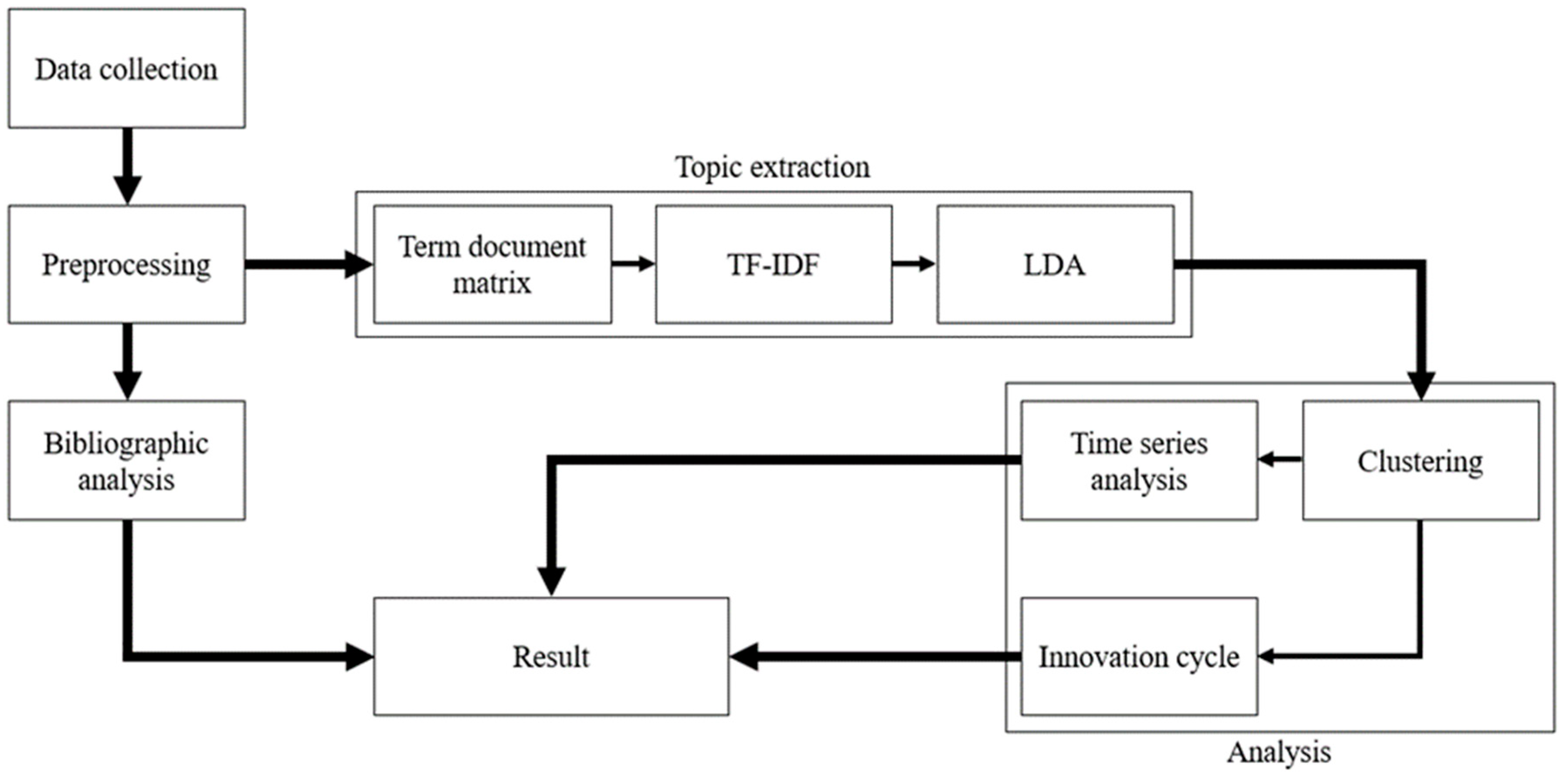
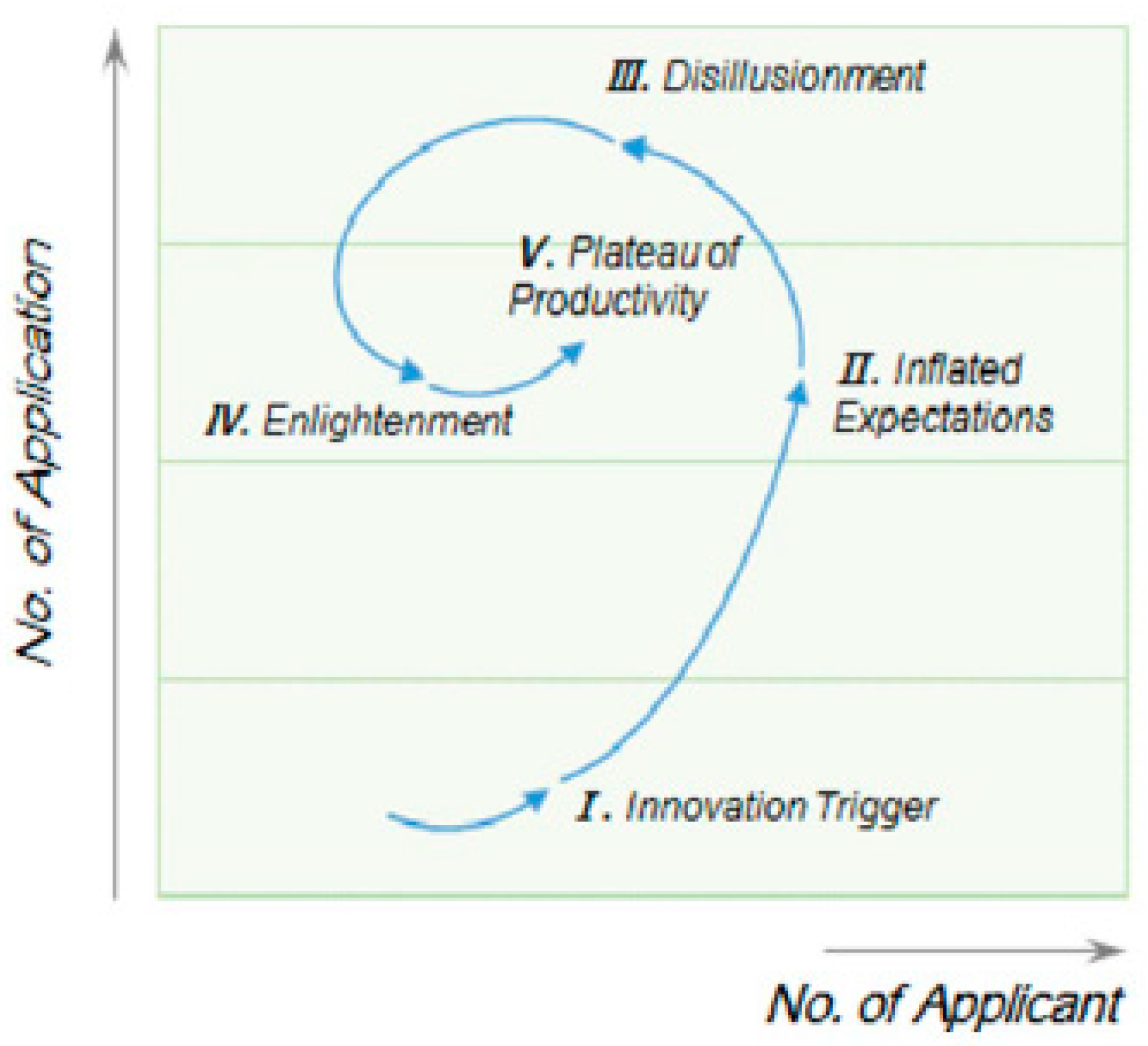
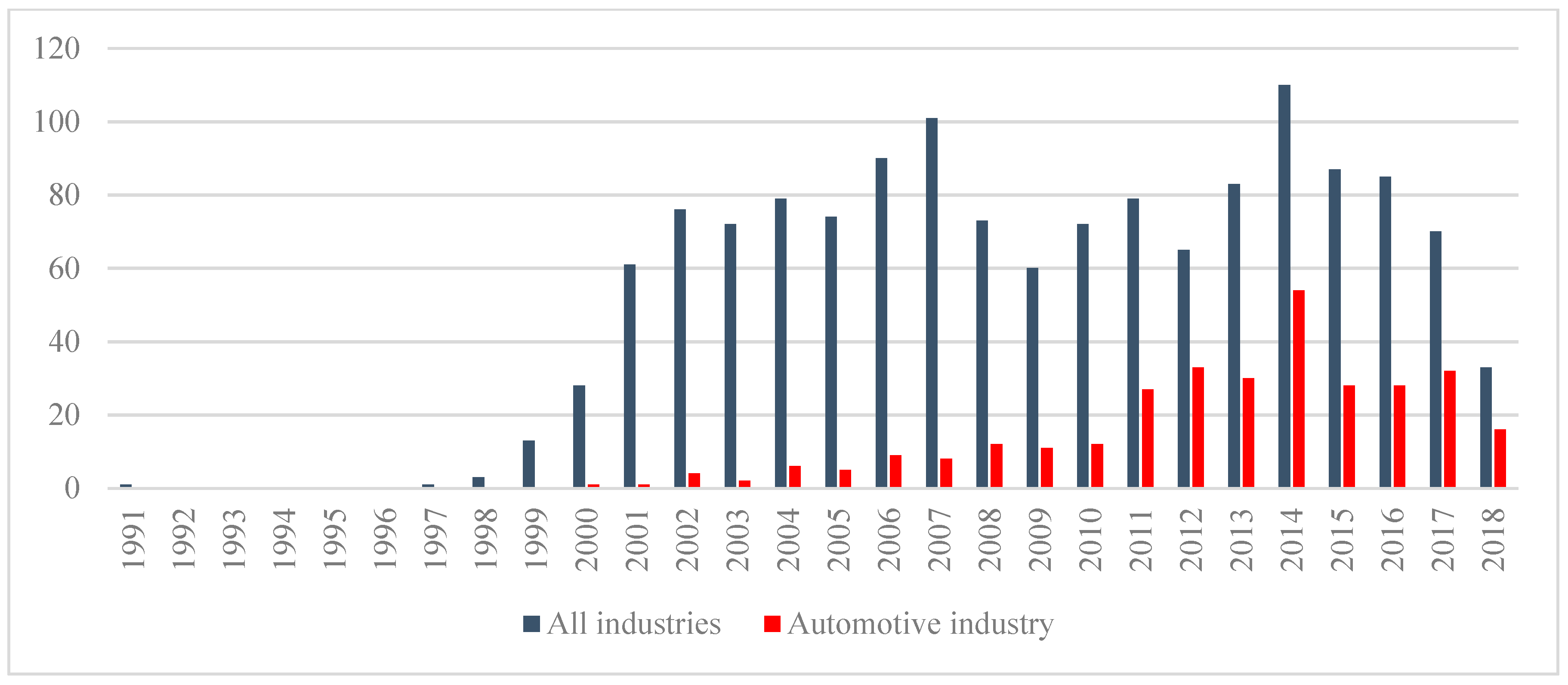

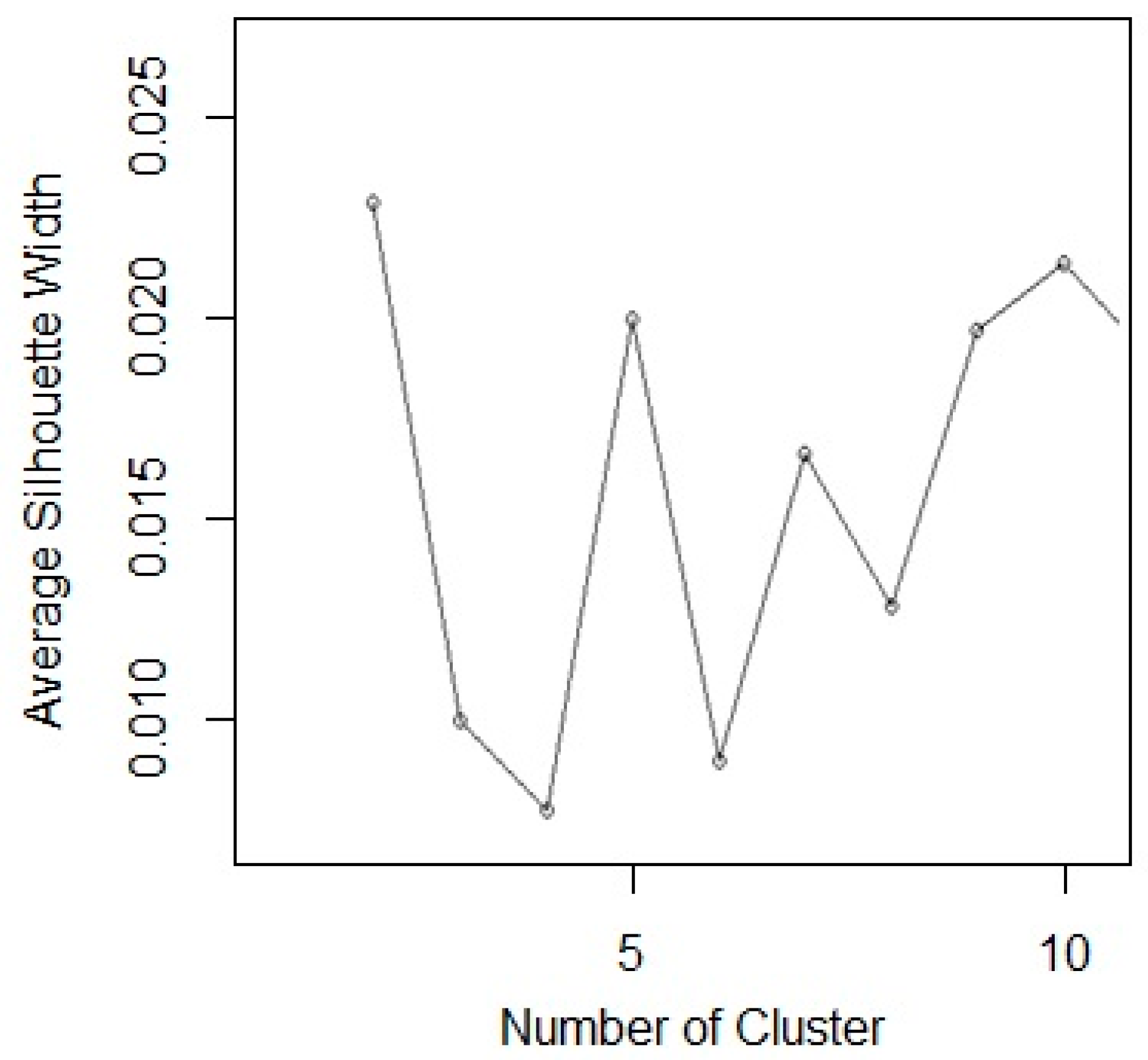

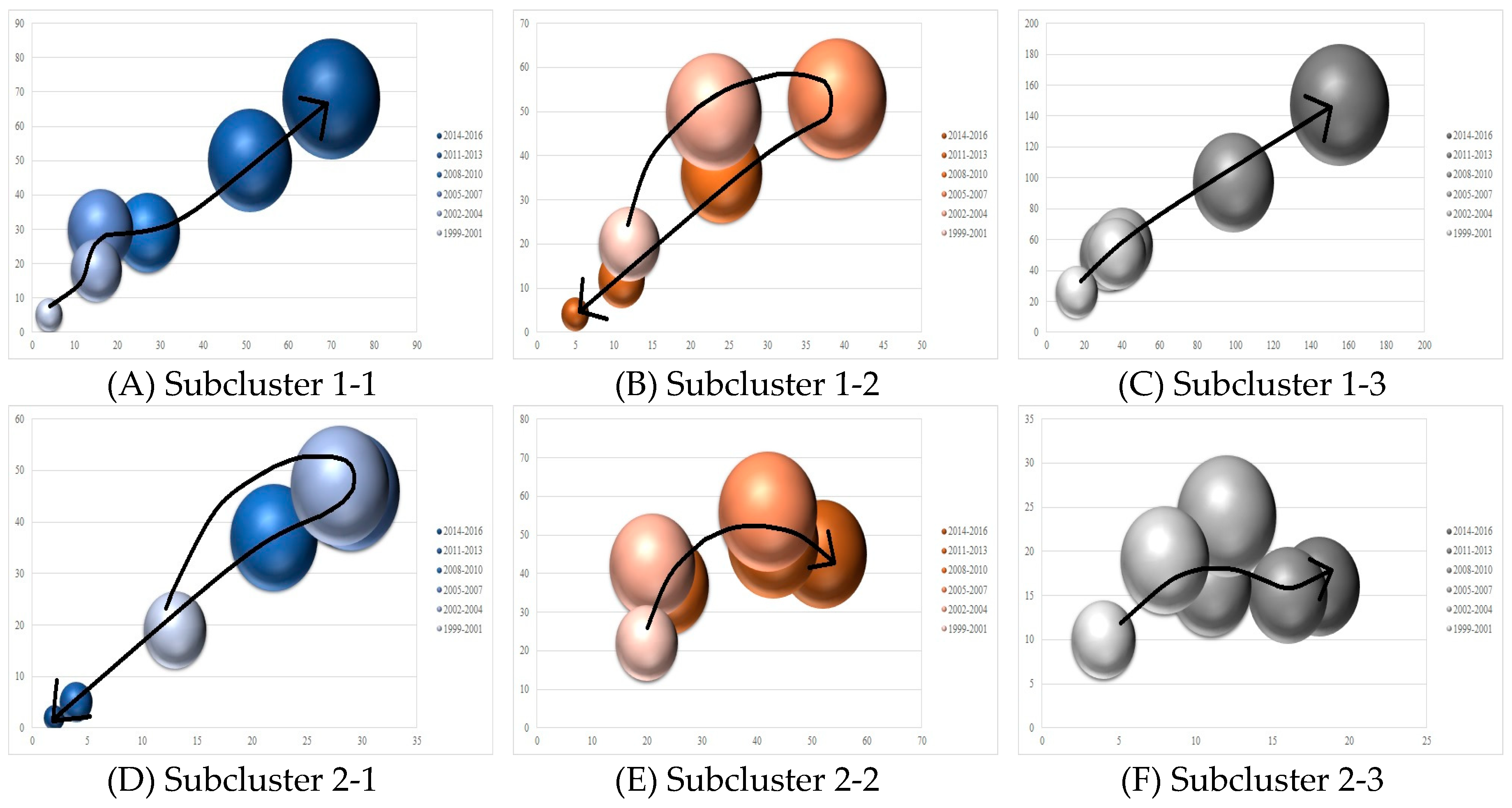
| Author | Method | Technology | Database |
|---|---|---|---|
| Altuntas et al. (2015) [45] | - Weighted association rule | - Database application - Database theory | USPTO |
| Caviggioli (2016) [62] | - Bibliometrics - Duration model | - All fields of technology | EPO 1 |
| Choi and Jun (2014) [60] | - Bayesian learning - Ensemble method | - Humanoid robot system | USPTO |
| Daim et al. (2006) [27] | - Bibliometrics - Delphi method - Growth curve | - Food safety - Fuel cell - Optical storage | USPTO |
| Joung and Kim (2017) [26] | - Hierarchical clustering algorithm - Keyword trend analysis - TF-IDF | - Electrochemical glucose biosensor | USPTO |
| Jun et al. (2012) [39] | - Association rule mining - K-means clustering - Time series analysis | - Biotechnology | USPTO |
| Jun et al. (2012) [52] | - K-medoids clustering - Matrix map - Support vector clustering | - Management of technology | USPTO |
| Kim and Bae (2017) [56] | - Bibliometrics - K-means clustering | - Wellness care | USPTO |
| Kim et al. (2015) [59] | - Latent Dirichlet allocation - Principal component analysis | - Renewable energy | USPTO |
| Kyebambe et al. (2017) [50] | - Supervised learning - Technology cycle time | - All fields of technology | USPTO |
| Lee et al. (2009) [53] | - Patent map - Principal component analysis | - Personal digital assistant (PDA) | USPTO |
| Lee et al. (2018) [46] | - Multilayer neural network | - Pharmaceutical | USPTO |
| Song et al. (2017) [48] | - Cosine similarity - S-curve | - Braking system | JPO 2 |
| Trappey et al. (2011) [40] | - Patent content clustering - Technology life cycle | - RFID | CNIPA |
| Yoon and Magee (2018) [54] | - Generative topology mapping - Link prediction | - 3D printing - Nuclear fusion - Water purification | USPTO |
| Application Number: 14/107220 | Title of Invention | Nonlinear system identification for optimization of wireless power transfer | |
| Applicant | Filing Date | Main IPC | |
| Nucleus Scientific Inc. | December 16th, 2013 | G01R-025/00 | |
| Abstract | |||
| A method of detecting whether a receiver coil is near a transmit coil in a wireless power transfer system (WPTS), the method involving: applying a pseudo-random signal to the transmit coil; while the pseudo-random signal is being applied to the transmit coil, recording one or more signals produced within the WPTS in response to the applied pseudo-random signal; by using the one or more recorded signals, generating a dynamic system model for some aspect of the WPTS; and using the generated dynamic system model in combination with stored training data to determine whether an object having characteristics distinguishing the object as a receiver coil is near the transmit coil. | |||
| Application Number: 14/362498 | Title of Invention | Method for the contactless charging of the battery of an electric automobile | |
| Applicant | Filing Date | Main IPC | |
| Renault S.A.S. | December 4th, 2012 | H02J-007/00 | |
| Abstract | |||
| A method for contactless charging of the battery of an electric automobile by magnetic induction using a transmitter coil of a charging device and a receiver coil of the vehicle, the method including: controlling a power supply of a converter, at terminals of which the transmitter coil is connected, according to a variable frequency; measuring, in an analog circuit, a value of a current and of a voltage at the terminals of the transmission coil; calculating a phase shift between the current and the voltage; converting the phase shift into a digital value; and locking the variable frequency of the converter to the phase-shift value by digital processing. | |||
| Application Number: 14/852795 | Title of Invention | Vehicle power-supplying system | |
| Applicant | Filing Date | Main IPC | |
| IHI Corporation | September 14th, 2015 | B60L-011/18 | |
| Abstract | |||
| A vehicle power-supplying system that wirelessly supply power to a vehicle includes a power-supplying coil installed at a location at which the vehicle can be stopped, first and second positioning posts whose positional relationship with the power-supplying coil is fixed, a position-identifying means installed in the vehicle and configured to identify a positional relationship of the power-supplying coil with the vehicle by detecting the first and second positioning posts, and a traveling support means configured to support traveling of the vehicle to the power-supplying coil based on the positional relationship with the power-supplying coil identified by the position-identifying means. | |||
| Rank | Applicant | Industry | Number of patents filed (patent share) |
|---|---|---|---|
| 1 | Toyota Motor Corporation (TMC) | Automotive | 123 (8.69%) |
| 2 | Qualcomm Incorporated | ICT | 63 (4.45%) |
| 3 | Hyundai Motor Company | Automotive | 35 (2.47%) |
| 4 | DENSO Corporation | Automotive | 34 (2.40%) |
| 5 | Ford Motor Company | Automotive | 32 (2.26%) |
| 6 | Nissan Motor Co., Ltd. | Automotive | 31 (2.19%) |
| 7 | Honda Motor Co., Ltd. | Automotive | 27 (1.91%) |
| 8 | IHI Corporation | Heavy industry | 23 (1.62%) |
| 9 | General Motors (GM) | Automotive | 19 (1.34%) |
| 10 | Delphi Technologies | Automotive | 18 (1.27%) |
| WiTricity Corporation | Electronics |
| Term | Doc1 | Doc2 | Doc3 | Doc4 | Doc5 | Doc6 | Doc7 | Doc8 | Doc9 | Doc10 |
|---|---|---|---|---|---|---|---|---|---|---|
| Batteri | 2 | 8 | 3 | 0 | 0 | 4 | 0 | 0 | 0 | 0 |
| Communic | 5 | 1 | 1 | 5 | 2 | 3 | 1 | 0 | 1 | 0 |
| Current | 1 | 0 | 0 | 0 | 0 | 0 | 0 | 0 | 0 | 0 |
| Devic | 2 | 0 | 0 | 0 | 5 | 1 | 4 | 4 | 1 | 0 |
| Dure | 1 | 0 | 0 | 0 | 0 | 0 | 0 | 0 | 0 | 0 |
| Electr | 1 | 0 | 2 | 0 | 0 | 6 | 0 | 0 | 0 | 0 |
| Emerg | 4 | 0 | 0 | 0 | 0 | 0 | 0 | 0 | 0 | 0 |
| Even | 1 | 0 | 0 | 1 | 0 | 0 | 0 | 0 | 0 | 0 |
| Execut | 1 | 0 | 0 | 0 | 0 | 0 | 0 | 0 | 0 | 0 |
| Finish | 1 | 0 | 0 | 0 | 0 | 0 | 0 | 0 | 0 | 0 |
| Term | Doc1 | Doc2 | Doc3 | Doc4 | Doc5 | Doc6 | Doc7 | Doc8 | Doc9 | Doc10 |
|---|---|---|---|---|---|---|---|---|---|---|
| Batteri | 0.09 | 0.30 | 0.10 | 0 | 0 | 0.11 | 0 | 0 | 0 | 0 |
| Communic | 0.16 | 0.03 | 0.02 | 0.13 | 0.05 | 0.06 | 0.02 | 0 | 0.06 | 0 |
| Current | 0.07 | 0 | 0 | 0 | 0 | 0 | 0 | 0 | 0 | 0 |
| Devic | 0.05 | 0 | 0 | 0 | 0.09 | 0.01 | 0.05 | 0.05 | 0.05 | 0 |
| Dure | 0.13 | 0 | 0 | 0 | 0 | 0 | 0 | 0 | 0 | 0 |
| Electr | 0.03 | 0 | 0.04 | 0 | 0 | 0.10 | 0 | 0 | 0 | 0 |
| Emerg | 0.45 | 0 | 0 | 0 | 0 | 0 | 0 | 0 | 0 | 0 |
| Even | 0.11 | 0 | 0 | 0.10 | 0 | 0 | 0 | 0 | 0 | 0 |
| Execut | 0.10 | 0 | 0 | 0 | 0 | 0 | 0 | 0 | 0 | 0 |
| Finish | 0.17 | 0 | 0 | 0 | 0 | 0 | 0 | 0 | 0 | 0 |
| Cluster | Keyword |
|---|---|
| Cluster 1 (882 patents) | Reception, energy, magnetic, portion, position, primary, transfer, electromagnetic, transmitter, source |
| Cluster 2 (534 patents) | Controller, circuit, plurality, sensor, transmitter, non-contact, communications, method, voltage, remote |
| Section | Title |
|---|---|
| A | Human necessities |
| B | Performing operations, transporting |
| C | Chemistry, metallurgy |
| D | Textiles, paper |
| E | Fixed constructions |
| F | Mechanical engineering, lighting, heating, weapons, blasting |
| G | Physics |
| H | Electricity |
| Cluster | Subcluster | IPC Section | Subtotal | Total | |||||||
|---|---|---|---|---|---|---|---|---|---|---|---|
| A | B | C | D | E | F | G | H | ||||
| 1 | 1 | 8.3 | 152.7 | 1.0 | 0 | 3.3 | 9.5 | 9.3 | 39.9 | 224 | 882 |
| 2 | 0 | 3.2 | 0 | 0 | 0 | 0 | 170.3 | 4.5 | 178 | ||
| 3 | 0.4 | 56.5 | 0 | 0 | 0.7 | 1.3 | 12.4 | 408.8 | 480 | ||
| 2 | 1 | 0 | 1.5 | 0 | 0 | 0.2 | 1.0 | 146.9 | 8.4 | 158 | 534 |
| 2 | 0.8 | 16.7 | 0 | 0 | 0.3 | 1.8 | 3.2 | 241.1 | 264 | ||
| 3 | 4.4 | 82.1 | 0 | 0 | 4.8 | 3.0 | 3.0 | 14.7 | 112 | ||
| Cluster | Subcluster | Dominant IPC Section | Keyword |
|---|---|---|---|
| 1 | 1 | B | Charging, reception, transmitting, transmission, resonator, electromagnetic, control, vehicle, apparatus, battery |
| 2 | G | Network, module, signal, wireless, USB 1, GPS 2, remote, tire, electronic, interface | |
| 3 | H | Coil, electric, receiving, energy, magnetic, transfer, primary, plurality, circuit, antenna | |
| 2 | 1 | G | Control, signal, battery, controller, speed, memory, apparatus, remote, circuit, plurality |
| 2 | H | Coil, charging, signal, wireless, electric, control, resonator, primary, voltage, electromagnetic | |
| 3 | B | Non-contact, heat, induction, detection, module, parking, transfer, pressure, remote, output |
| Subcluster | Clustering | Time series | Innovation cycle |
|---|---|---|---|
| Subcluster 1-1 | Underdeveloped | Development stage | Level 1-2 |
| Subcluster 1-2 | Underdeveloped | Decline stage | Level 4 |
| Subcluster 1-3 | Well-developed | Growth stage | Level 2 |
| Subcluster 2-1 | Underdeveloped | Decline stage | Level 4 |
| Subcluster 2-2 | Well-developed | Maturity stage | Level 3 |
| Subcluster 2-3 | Underdeveloped | Development stage | Level 1 |
© 2019 by the authors. Licensee MDPI, Basel, Switzerland. This article is an open access article distributed under the terms and conditions of the Creative Commons Attribution (CC BY) license (http://creativecommons.org/licenses/by/4.0/).
Share and Cite
Kim, K.H.; Han, Y.J.; Lee, S.; Cho, S.W.; Lee, C. Text Mining for Patent Analysis to Forecast Emerging Technologies in Wireless Power Transfer. Sustainability 2019, 11, 6240. https://doi.org/10.3390/su11226240
Kim KH, Han YJ, Lee S, Cho SW, Lee C. Text Mining for Patent Analysis to Forecast Emerging Technologies in Wireless Power Transfer. Sustainability. 2019; 11(22):6240. https://doi.org/10.3390/su11226240
Chicago/Turabian StyleKim, Ki Hong, Young Jae Han, Sugil Lee, Sung Won Cho, and Chulung Lee. 2019. "Text Mining for Patent Analysis to Forecast Emerging Technologies in Wireless Power Transfer" Sustainability 11, no. 22: 6240. https://doi.org/10.3390/su11226240
APA StyleKim, K. H., Han, Y. J., Lee, S., Cho, S. W., & Lee, C. (2019). Text Mining for Patent Analysis to Forecast Emerging Technologies in Wireless Power Transfer. Sustainability, 11(22), 6240. https://doi.org/10.3390/su11226240







